Blueberry
| Blueberry | |
|---|---|
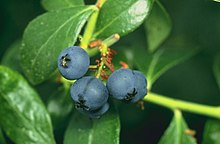
| |
| Vaccinium caesariense | |
| Scientific classification | |
| Kingdom: | Plantae |
| Clade: | Tracheophytes |
| Clade: | Angiosperms |
| Clade: | Eudicots |
| Clade: | Asterids |
| Order: | Ericales |
| Family: | Ericaceae |
| Genus: | Vaccinium |
| Section: | Vaccinium sect. Cyanococcus Rydb. |
| Species | |
|
See text | |

Blueberry is a widely distributed and widespread group of perennial flowering plant with blue or purple berries. They are classified in the section Cyanococcus within the genus Vaccinium. Vaccinium also includes cranberries, bilberries, huckleberries and Madeira blueberries.[1] Commercial blueberries—both wild (lowbush) and cultivated (highbush)—are all native to North America. The highbush varieties were introduced into Europe during the 1930s.[2]
Blueberries are usually prostrate shrubs that can vary in size from 10 centimeters (4 inches) to 4 meters (13 feet) in height. In commercial production of blueberries, the species with small, pea-size berries growing on low-level bushes are known as "lowbush blueberries" (synonymous with "wild"), while the species with larger berries growing on taller, cultivated bushes are known as "highbush blueberries". Canada is the leading producer of lowbush blueberries, while the United States produces some 40% of the world supply of highbush blueberries.
Origin and history of cultivation[edit]
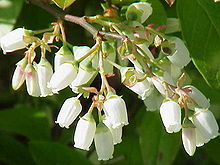

The genus Vaccinium has a mostly circumpolar distribution, with species mainly present in North America, Europe, and Asia.[1] Many commercially available species with English common names including "blueberry" are from North America,[3] particularly Atlantic Canada and the northeastern United States for wild (lowbush) blueberries, and several US states and British Columbia for cultivated (highbush) blueberries.[4][5] First Nations peoples of Canada consumed wild blueberries for millennia.[4] Highbush blueberries were first cultivated in New Jersey around the beginning of the 20th century.[5][3]
North American native species of blueberries are grown commercially in the Southern Hemisphere in Australia, New Zealand and South American nations. The Colombian or Andean blueberry, Vaccinium meridionale, is wild-harvested and commonly available locally.[6] Several other wild shrubs of the genus Vaccinium also produce commonly eaten blue berries, such as the predominantly European Vaccinium myrtillus and other bilberries, which in many languages have a name that translates to "blueberry" in English.
Description[edit]
Five species of blueberries grow wild in Canada, including Vaccinium myrtilloides, Vaccinium angustifolium and Vaccinium corymbosum, which grow on forest floors or near swamps.[7] Wild (lowbush) blueberries are not planted by farmers, but rather are managed on berry fields called "barrens".[4]
Wild blueberries reproduce by cross pollination, with each seed producing a plant with a different genetic composition, causing within the same species differences in growth, productivity, color, leaf characteristics, disease resistance, flavor, and other fruit characteristics.[7] The mother plant develops underground stems called rhizomes, allowing the plant to form a network of rhizomes creating a large patch (called a clone) which is genetically distinct.[7] Floral and leaf buds develop intermittently along the stems of the plant, with each floral bud giving rise to 5–6 flowers and the eventual fruit.[7] Wild blueberries prefer an acidic soil between 4.2 and 5.2 pH and only moderate amounts of moisture.[7] They have a hardy cold tolerance in their Canadian range and the U.S. state of Maine.[7] Fruit productivity of lowbush blueberries varies by the degree of pollination, genetics of the clone, soil fertility, water availability, insect infestation, plant diseases and local growing conditions.[7] Wild (lowbush) blueberries have an average mature weight of 0.3 grams (1⁄128 oz).[7]
Highbush (cultivated) blueberries prefer sandy or loam soils, having shallow root systems that benefit from mulch and fertilizer.[8] The leaves of highbush blueberries can be either deciduous or evergreen, ovate to lanceolate, and 1–8 cm (1⁄2–3+1⁄4 in) long and 0.5–3.5 cm (1⁄4–1+3⁄8 in) broad. The flowers are bell-shaped, white, pale pink or red, sometimes tinged greenish.
The fruit is a berry 5–16 mm (3⁄16–5⁄8 in) in diameter with a flared crown at the end; they are pale greenish at first, then reddish-purple, and finally uniformly blue when ripe.[8] They are covered in a protective coating of powdery epicuticular wax, colloquially known as the "bloom".[7] They generally have a sweet taste when mature, with variable acidity.[7][8] Blueberry bushes typically bear fruit in the middle of the growing season: fruiting times are affected by local conditions such as climate, altitude and latitude, so the time of harvest in the northern hemisphere can vary from May to August.[7][8]
Species[edit]
This section needs additional citations for verification. (March 2020) |
Note: habitat and range summaries are from the Flora of New Brunswick, published in 1986 by Harold R. Hinds, and Plants of the Pacific Northwest coast, published in 1994 by Pojar and MacKinnon.
- Vaccinium angustifolium (lowbush blueberry):[9][3] acidic barrens, bogs and clearings, Manitoba to Labrador, south to Nova Scotia; and in the United States, from Maine westward to Iowa and southward to Virginia
- Vaccinium boreale (northern blueberry): peaty barrens, Quebec and Labrador (rare in New Brunswick), south to New York and Massachusetts
- Vaccinium caesariense (New Jersey blueberry)
- Vaccinium corymbosum (northern highbush blueberry)[9]
- Vaccinium darrowii (evergreen blueberry)
- Vaccinium elliottii (Elliott blueberry)
- Vaccinium formosum (southern blueberry)
- Vaccinium fuscatum (black highbush blueberry; syn. V. atrococcum)
- Vaccinium hirsutum (hairy-fruited blueberry)
- Vaccinium myrsinites (shiny blueberry)
- Vaccinium myrtilloides (sour top, velvet leaf, or Canadian blueberry)
- Vaccinium pallidum (dryland blueberry)
- Vaccinium simulatum (upland highbush blueberry)
- Vaccinium tenellum (southern blueberry)
- Vaccinium virgatum (rabbiteye blueberry; syn. V. ashei)[9]
Some other blue-fruited species of Vaccinium:
- Vaccinium koreanum (Korean blueberry)
- Vaccinium myrtillus (bilberry or European blueberry)
- Vaccinium uliginosum (bog bilberry/blueberry, northern bilberry or western blueberry)
-
Wild blueberry in autumn foliage, Pilot Mountain, North Carolina, in October
-
A maturing 'Polaris' blueberry (Vaccinium corymbosum)
-
A selection of blueberries, showing the typical sizes of the berries. The scale is marked in centimeters.
The lowbush varieties are V. angustifolium, V. boreale, V. mytilloides, V. pallidum, and V. angustifolium × V. corymbosum. They are still grown in a similar manner to pre-Columbian semi-wild cultivation, i.e. slash and burn. The highbush varieties are darrowii and corymbosum. Rabbiteye (V. ashei/V. virgatum) is considered different from both high- and lowbush.[3]
Identification[edit]
Commercially offered blueberries are usually from species that naturally occur only in eastern and north-central North America. Other sections in the genus are native to other parts of the world, including the Pacific Northwest and southern United States,[10] South America, Europe and Asia. Other wild shrubs in many of these regions produce similar-looking edible berries, such as huckleberries and whortleberries (North America) and bilberries (Europe). These species are sometimes called "blueberries" and are sold as blueberry jam or other products.
The names of blueberries in languages other than English often translate as "blueberry", e.g. Scots blaeberry and Norwegian blåbær. Blaeberry, blåbær and French myrtilles usually refer to the European native bilberry (V. myrtillus), while bleuets refers to the North American blueberry. Russian голубика ("blue berry") does not refer to blueberries, which are non-native and nearly unknown in Russia, but rather to their close relatives, bog bilberries (V. uliginosum).
Cyanococcus blueberries can be distinguished from the nearly identical-looking bilberries by their flesh color when cut in half. Ripe blueberries have light green flesh, while bilberries, whortleberries and huckleberries are red or purple throughout.
 A dish of blueberries | |
| Nutritional value per 100 g (3.5 oz) | |
|---|---|
| Energy | 240 kJ (57 kcal) |
14.49 g | |
| Sugars | 9.96 g |
| Dietary fiber | 2.4 g |
0.33 g | |
0.74 g | |
| Vitamins | Quantity %DV† |
| Vitamin A equiv. | 0% 32 μg80 μg |
| Vitamin A | 54 IU |
| Thiamine (B1) | 3% 0.037 mg |
| Riboflavin (B2) | 3% 0.041 mg |
| Niacin (B3) | 3% 0.418 mg |
| Pantothenic acid (B5) | 2% 0.124 mg |
| Vitamin B6 | 3% 0.052 mg |
| Folate (B9) | 2% 6 μg |
| Vitamin C | 11% 9.7 mg |
| Vitamin E | 4% 0.57 mg |
| Vitamin K | 16% 19.3 μg |
| Minerals | Quantity %DV† |
| Calcium | 0% 6 mg |
| Iron | 2% 0.28 mg |
| Magnesium | 1% 6 mg |
| Manganese | 15% 0.336 mg |
| Phosphorus | 1% 12 mg |
| Potassium | 3% 77 mg |
| Sodium | 0% 1 mg |
| Zinc | 2% 0.165 mg |
| Other constituents | Quantity |
| Water | 84 g |
| †Percentages estimated using US recommendations for adults,[11] except for potassium, which is estimated based on expert recommendation from the National Academies.[12] | |
Culinary use[edit]
Blueberries are sold fresh or are processed as individually quick frozen (IQF) fruit, purée, juice, or dried or infused berries. These may then be used in a variety of consumer goods, such as jellies, jams, pies, muffins, snack foods, pancakes, or as an additive to breakfast cereals.
Blueberry jam is made from blueberries, sugar, water, and fruit pectin. Blueberry sauce is a sweet sauce prepared using blueberries as a primary ingredient.
Blueberry wine is made from the flesh and skin of the berries, which is fermented and then matured; usually the lowbush variety is used.
Nutrients[edit]
Blueberries consist of 14% carbohydrates, 0.7% protein, 0.3% fat and 84% water (table). They contain only negligible amounts of micronutrients, with moderate levels (relative to respective Daily Values) (DV) of the essential dietary mineral manganese, vitamin C, vitamin K and dietary fiber (table). Generally, nutrient contents of blueberries are a low percentage of the DV (table). A 100-gram serving provides a relatively low amount of food energy – 240 kilojoules (57 kcal) – with a glycemic load of 6.
Phytochemicals and research[edit]
Blueberries contain anthocyanins, other polyphenols and various phytochemicals under preliminary research for their potential biological effects.[13] Most polyphenol studies have been conducted using the highbush cultivar of blueberries (V. corymbosum), while content of polyphenols and anthocyanins in lowbush (wild) blueberries (V. angustifolium) exceeds values found in highbush cultivars.[14]
-
A cut blueberry showing how, having been frozen and then thawed, the anthocyanins in the pericarp are able to run into the damaged cells, staining the flesh.
-
Structure of anthocyanins, the blue pigments in blueberries.[13]
Cultivation[edit]

Blueberries may be cultivated, or they may be picked from semiwild or wild bushes. In North America, the most common cultivated species is V. corymbosum, the northern highbush blueberry. Hybrids of this with other Vaccinium species adapted to southern U.S. climates are known collectively as southern highbush blueberries.[15]
So-called "wild" (lowbush) blueberries, smaller than cultivated highbush ones, have intense color. The lowbush blueberry, V. angustifolium, is found from the Atlantic provinces westward to Quebec and southward to Michigan and West Virginia. In some areas, it produces natural "blueberry barrens", where it is the dominant species covering large areas. Several First Nations communities in Ontario are involved in harvesting wild blueberries.
"Wild" has been adopted as a marketing term for harvests of managed native stands of lowbush blueberries. The bushes are not planted or selectively bred, but they are pruned or burned over every two years, and pests are "managed".[16]
Numerous highbush cultivars of blueberries are available, with diversity among them, each having individual qualities. A blueberry breeding program has been established by the USDA-ARS breeding program at Beltsville, Maryland, and Chatsworth, New Jersey. This program began when Frederick Vernon Coville of the USDA-ARS collaborated with Elizabeth Coleman White of New Jersey.[17] In the early part of the 20th century, White offered pineland residents cash for wild blueberry plants with unusually large fruit.[18] After 1910 Coville began to work on blueberry, and was the first to discover the importance of soil acidity (blueberries need highly acidic soil), that blueberries do not self-pollinate, and the effects of cold on blueberries and other plants.[19] In 1911, he began a program of research in conjunction with White, daughter of the owner of the extensive cranberry bogs at Whitesbog in the New Jersey Pine Barrens. His work doubled the size of some strains' fruit, and by 1916, he had succeeded in cultivating blueberries, making them a valuable crop in the Northeastern United States.[18][20] For this work he received the George Roberts White Medal of Honor from the Massachusetts Horticultural Society.
The rabbiteye blueberry (Vaccinium virgatum syn. V. ashei) is a southern type of blueberry produced from the Carolinas to the Gulf Coast states. Production of rabbiteye blueberries was a focus in Texas in the early 21st century.[21] Other important species in North America include V. pallidum, the hillside or dryland blueberry. It is native to the eastern U.S., and common in the Appalachians and the Piedmont of the Southeast. Sparkleberry, V. arboreum, is a common wild species on sandy soils in the Southeast.
Successful blueberry cultivation requires attention to soil pH (acidity) measurements in the acidic range.[22][23][24]
Blueberry bushes often require supplemental fertilization,[23] but over-fertilization with nitrogen can damage plant health, as evidenced by nitrogen-burn visible on the leaves.[22][23]
Growing regions[edit]
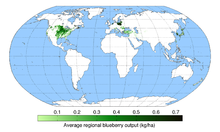
Significant production of highbush blueberries occurs in British Columbia, Maryland, Western Oregon, Michigan, New Jersey, North Carolina, and Washington. The production of southern highbush varieties occurs in California, as varieties originating from University of Florida, Connecticut, New Hampshire, North Carolina State University and Maine have been introduced. Peru, Spain, and Mexico also have significant production, as of 2018 (see Production).[25]
United States[edit]
In 2018, Oregon produced the most cultivated blueberries, recording 59 million kilograms (131 million pounds), an amount slightly exceeding the production by Washington.[26] In descending order of production volume for 2017, other major producers were Georgia, Michigan, New Jersey, California, and North Carolina.[27]
Hammonton, New Jersey, claims to be the "Blueberry Capital of the World",[28] with over 80% of New Jersey's cultivated blueberries coming from this town.[29] Every year the town hosts a large festival, which draws thousands of people to celebrate the fruit.[30]
Maine is known for its wild blueberries,[31] but the state's lowbush (wild) and highbush blueberries combined account for 10% of all blueberries grown in North America. Some 44,000 hectares (110,000 acres) are farmed, but only half of this acreage is harvested each year due to variations in pruning practices.[32] The wild blueberry is the official fruit of Maine.[33]
Canada[edit]

Canadian production of wild and cultivated blueberries in 2015 was 166,000 tonnes valued at $262 million, the largest fruit crop produced nationally accounting for 29% of all fruit value.[34]
British Columbia was the largest Canadian producer of cultivated blueberries, yielding 70,000 tonnes in 2015,[34] the world's largest production of blueberries by region.[35]
Atlantic Canada contributes approximately half of the total North American wild/lowbush annual production with New Brunswick having the largest in 2015, an amount expanding in 2016.[36] Nova Scotia, Prince Edward Island and Québec are also major producers.[37] Nova Scotia recognizes the wild blueberry as its official provincial berry,[38] with the town of Oxford, Nova Scotia known as the Wild Blueberry Capital of Canada.[39]
Québec is a major producer of wild blueberries, especially in the regions of Saguenay-Lac-Saint-Jean (where a popular name for inhabitants of the regions is bleuets, or "blueberries") and Côte-Nord, which together provide 40% of Québec's total provincial production. This wild blueberry commerce benefits from vertical integration of growing, processing, frozen storage, marketing and transportation within relatively small regions of the province.[40] On average, 80% of Québec wild blueberries are harvested on farms (21 million kilograms (23,000 short tons)), the remaining 20% being harvested from public forests (5 million kilograms (5,500 short tons)).[40] Some 95% of the wild blueberry crop in Québec is frozen for export out of the province.[40]
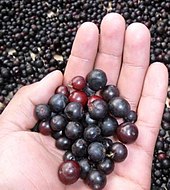
Europe[edit]
Highbush blueberries were first introduced to Germany, Sweden and the Netherlands in the 1930s, and have since been spread to numerous other countries of Europe.[2] V. corymbosum only began to be cultivated in Romania in a few years leading up to 2018 and rapidly increased in production and sales in that time (as with berries in general). As of 2018[update] it remains relatively unmolested by pests and diseases (see Diseases below).[41]
Southern Hemisphere[edit]
In the Southern Hemisphere, Brazil, Chile, Argentina, Peru, Uruguay, New Zealand, Australia, South Africa,[42] and Zimbabwe grow blueberries commercially.[43]
In Brazil, blueberries are produced in the states of Rio Grande do Sul, Santa Catarina, Paraná, São Paulo and Minas Gerais.[44]
Blueberries were first introduced to Australia in the 1950s, but the effort was unsuccessful. In the early 1970s, the Victorian Department of Agriculture imported seed from the U.S. and a selection trial was started. This work was continued into the mid-1970s when the Australian Blueberry Growers' Association was formed.[45]
In the 21st century, the industry grew in Argentina: "Argentine blueberry production has increased over the last three years with planted area up to 400 percent," according to a 2005 report by the U.S. Department of Agriculture.[46] "Argentine blueberry production has thrived in four different regions: the province of Entre Rios in northeastern Argentina, the province of Tucuman, the province of Buenos Aires and the southern Patagonian valleys", according to the report.[47] In the Bureau of International Labor Affairs report of 2014 on child labor and forced labor, blueberries were listed among the goods produced in such working conditions in Argentina.[48]
Pests and diseases[edit]
Diseases[edit]
As of 2018[update] V. corymbosum remains relatively unmolested by pests and diseases in Romania, with Phytophthora cinnamomi, Monilinia vaccinii-corymbosi, Botryosphaeria corticis, Godronia cassandrae, Phomopsis sp., Botrytis cinerea, Naohidemyces vaccinii, Microsphaera penicillata var. vaccinii, and various viruses being the most common.[41]
Pest management[edit]
Pesticides[edit]
DDT began to be used in blueberry soon after its discovery in 1939, and a few years later in the mid-1940s research began into its use in North America.[3]
Because "wild" is a marketing term generally used for all low-bush blueberries, it is not an indication that such blueberries are free from pesticides.[49]
Insecticide modes of action must be varied to avoid encouraging resistance in the invasive pest Drosophila suzukii.[3]
Some insecticides can be counterproductive, harming natural enemies of pests as well. For example, treatment for Illinoia pepperi can reduce populations of its predators. Kaolin clay for Rhagoletis mendax also reduced effectiveness of Diachasma alloeum, its parasitoid. The pest predator Harpalus erraticus maintains greater abundance with selective insecticides rather than broad-spectrum MoAs.[3]
Integrated pest management[edit]
Blueberries are naturally relatively unmolested by arthropod pests. Nonetheless, there are 24 insect taxa known to be pest (organism)s in North America, the worst in New Jersey, Michigan, Maine, and Eastern Canada being Rhagoletis mendax. Secondary but still important are Acrobasis vaccinii, Grapholita packardi, and Conotrachelus nenuphar. These four are the most common targets for development of IPM practices. as of 2019[update], IPM research has also taken an interest in Drosophila suzukii and arthropods like aphids (that vector diseases such as scorch virus and shoestring virus) and cicadellids (vectoring the phytoplasma that causes blueberry stunt). Managing pests down to the cosmetic level is necessary in this fruit because they are a premium type product.[3]
Changes in locale and environment – to new geographies, and into greenhouses – has required new pest management regimes, including innovative IPM. Conversely, importing foreign potential enemies into North America may yield good results: Operophtera brumata is a pest of blueberries and birches which is successfully parasitized by Cyzenis albicans despite the lack of historical, natural contact between the two. The same results were obtained with Scirtothrips citri and Beauveria bassiana. Results are available for Choristoneura rosaceana and overwhelming numbers of Trichogramma minutum, and Cyclocephala longula overwhelmed by Steinernema scarabaei. This has also been attempted with flower thrips and potential predators but with inconclusive results.[3]
International quarantine[edit]
Rhagoletis mendax is a quarantine pest in phytosanitary regimes of some countries around the world.[3]
Resistant cultivars[edit]
Insect resistance was not a priority in breeding programs until about the year 2000, and is still not a high priority. However it may become more common as it becomes easier, especially using marker-assisted breeding. V. ashei is naturally more resistant than V. corymbosum to Scaphytopius magdalensis. V. ashei is less resistant than V. darrowii to Prodiplosis vaccinia. There is variation between cultivars of V. ashei in resistance to Oberea myops. There is variation in resistance among cultivars of V. corymbosum to Acrobasis vaccinii and Popillia japonica. Wild V. spp. have greater resistance than highbush cultivars to I. pepperi. There is significant variation between highbush cultivars in abundance of various Tephritidae, thrips, and Homalodisca vitripennis.[3]
Production[edit]
| Country | Production (tonnes) |
|---|---|
| 351,130 | |
| 227,971 | |
| 146,551 | |
| 122,795 | |
| 66,482 | |
| 61,230 | |
| World | 1,113,261 |
| Source: FAOSTAT of the United Nations[50] | |
In 2021, world production of blueberries (lowbush and highbush combined) was 1.1 million tonnes, led by the United States with 32% of global production, Peru with 20%, and Canada with 13% (table).[50]
In 2019, Canada was the largest producer of wild blueberries, mainly in Quebec and the Atlantic provinces,[51] but Canadian production of wild blueberries decreased since 2017 by transitioning to the more profitable cultivated highbush blueberries.[52] British Columbia produced 93% of the Canadian highbush blueberry crop in 2019.[51]
Regulations[edit]
Canada[edit]
Canada No. 1 blueberries are all similar in size, shape, weight, and color—the total product can be no more than ten percent off-color and three percent otherwise defective.[53]
See also[edit]
References[edit]
- ^ a b Lisa J. Rowland; Freddi A. Hammerschlag (2005). Richard E. Litz (ed.). Vaccinium spp. (8.1: Blueberry). In: Biotechnology of Fruit and Nut Crops: Volume 29 of Biotechnology in Agriculture Series. CABI. ISBN 0-85199-066-5. Archived from the original on December 12, 2020. Retrieved September 21, 2020.
- ^ a b Naumann, W. D. (1993). "Overview of the Vaccinium Industry in Western Europe". In K. A. Clayton-Greene (ed.). Fifth International Symposium on Vaccinium Culture. Wageningen, the Netherlands: International Society for Horticultural Science. pp. 53–58. ISBN 978-90-6605-475-2. OCLC 29663461. Archived from the original on March 11, 2007. Retrieved August 25, 2006.
- ^ a b c d e f g h i j k Rodriguez-Saona, Cesar; Vincent, Charles; Isaacs, Rufus (January 7, 2019). "Blueberry IPM: Past Successes and Future Challenges". Annual Review of Entomology. 64 (1). Annual Reviews: 95–114. doi:10.1146/annurev-ento-011118-112147. ISSN 0066-4170. PMID 30629894. S2CID 58573080.
- ^ a b c "Canadian blueberries". Agriculture and Agri-Food Canada, Government of Canada. August 9, 2018. Archived from the original on February 20, 2020. Retrieved February 5, 2020.
- ^ a b "Blueberries – Celebrating 100 Years". Blueberry.org. US Highbush Blueberry Council. 2020. Archived from the original on April 9, 2020. Retrieved February 5, 2020.
- ^ Foster, Steven (2012). "The Adulteration of Commercial Bilberry Extracts" (PDF). Academia. Archived from the original (PDF) on May 16, 2021. Retrieved May 16, 2021 – via Herbalgram.
- ^ a b c d e f g h i j k "Wild Blueberry Fact Sheet A.2.0. Growth and Development of the Wild Blueberry" (PDF). Agriculture, Aquaculture and Fisheries, Province of New Brunswick, Canada. Archived (PDF) from the original on July 17, 2017. Retrieved February 5, 2020.
- ^ a b c d Becky Sideman (August 1, 2016). "Growing fruit: Highbush blueberries" (PDF). University of New Hampshire Cooperative Extension. Archived (PDF) from the original on September 25, 2020. Retrieved February 5, 2020.
- ^ a b c Plunkett, Blue J.; Espley, Richard V.; Dare, Andrew P.; Warren, Ben A. W.; Grierson, Ella R. P.; Cordiner, Sarah; Turner, Janice L.; Allan, Andrew C.; Albert, Nick W.; Davies, Kevin M.; Schwinn, Kathy E. (September 11, 2018). "MYBA From Blueberry (Vaccinium Section Cyanococcus) Is a Subgroup 6 Type R2R3MYB Transcription Factor That Activates Anthocyanin Production". Frontiers in Plant Science. 9: 1300. doi:10.3389/fpls.2018.01300. ISSN 1664-462X. PMC 6141686. PMID 30254656.
- ^ "Plants Profile: Vaccinium corymbosum L., Highbush blueberry". US Department of Agriculture, National Resources Conservation Service. 2013. Archived from the original on May 2, 2013. Retrieved April 30, 2013.
- ^ United States Food and Drug Administration (2024). "Daily Value on the Nutrition and Supplement Facts Labels". Retrieved March 28, 2024.
- ^ National Academies of Sciences, Engineering, and Medicine; Health and Medicine Division; Food and Nutrition Board; Committee to Review the Dietary Reference Intakes for Sodium and Potassium (2019). Oria, Maria; Harrison, Meghan; Stallings, Virginia A. (eds.). Dietary Reference Intakes for Sodium and Potassium. The National Academies Collection: Reports funded by National Institutes of Health. Washington (DC): National Academies Press (US). ISBN 978-0-309-48834-1. PMID 30844154.
{{cite book}}: CS1 maint: multiple names: authors list (link) - ^ a b "Flavonoids". Micronutrient Information Center, Linus Pauling Institute, Oregon State University, Corvallis, OR. November 2015. Archived from the original on October 24, 2019. Retrieved December 25, 2017.
- ^ Kalt W, Ryan DA, Duy JC, Prior RL, Ehlenfeldt MK, Vander Kloet SP (October 2001). "Interspecific variation in anthocyanins, phenolics, and antioxidant capacity among genotypes of highbush and lowbush blueberries (Vaccinium cyanococcus spp.)". J Agric Food Chem. 49 (10): 4761–7. doi:10.1021/jf010653e. ISSN 0021-8561. PMID 11600018.
- ^ "Growing Highbush Blueberries" (PDF). University of New Hampshire-Extension. Archived (PDF) from the original on September 27, 2013. Retrieved September 22, 2013.
- ^ "Wild Blueberry Network Information Centre". Wild Blueberry Network Information Centre. Archived from the original on October 15, 2018. Retrieved October 15, 2018.
- ^ "Blueberry Growing Comes to the National Agricultural Library". US Department of Agriculture, Agricultural Research Magazine, Vol. 59, No. 5. June 2011. Archived from the original on July 9, 2011. Retrieved June 17, 2011.
- ^ a b "The History of Whitesbog Village". Whitesbog.org. 2014. Archived from the original on May 15, 2008. Retrieved October 11, 2011.
- ^ Mirsky, Steve. "Early 20th Century Botanist Gave Us Domesticated Blueberries". Scientific American. Archived from the original on September 27, 2013. Retrieved September 21, 2013.
- ^ Jim Minick (June 29, 2016). "The Delicious Origins of The Domesticated Blueberry". JSTOR News. Archived from the original on February 8, 2018. Retrieved June 30, 2016.
- ^ Monte Nesbitt; Jim Kamas; Larry Stein (2013). "Blueberries" (PDF). Texas A&M University, AgriLife Extension Service. Archived (PDF) from the original on September 5, 2019. Retrieved April 27, 2019.
- ^ a b Longstroth M (2014). "Lowering the soil pH with sulfur" (PDF). Michigan State University. Archived from the original (PDF) on November 16, 2015. Retrieved August 24, 2015.
- ^ a b c Hayden RA (2001). "Fertilizing blueberries" (PDF). Purdue University, Department of Horticulture. Archived (PDF) from the original on October 11, 2015. Retrieved September 5, 2015.
- ^ "Cornell fruit: berry diagnostic tool". Cornell University, Department of Horticulture. 2013. Archived from the original on September 12, 2015. Retrieved September 5, 2015.
- ^ "Where Are Blueberries Grown?". World Atlas. April 25, 2017. Archived from the original on April 27, 2019. Retrieved April 27, 2019.
- ^ Mitch Lies (December 31, 2018). "Record year makes Oregon top blueberry producer". Capital Press. Salem, OR. Archived from the original on April 27, 2019. Retrieved April 27, 2019.
- ^ "Top 10 Blueberry Producing States In America". World Atlas. 2019. Archived from the original on April 27, 2019. Retrieved April 27, 2019.
- ^ "Home: Welcome to the Town of Hammonton". Town of Hammonton. September 11, 2013. Archived from the original on November 11, 2013. Retrieved November 6, 2013.
- ^ "The Beautiful Blueberry!". Pineypower.com. 2018. Archived from the original on July 11, 2018. Retrieved July 10, 2018.
- ^ "Hammonton Chamber of Commerce". Hammontonnj.us. 2018. Archived from the original on December 12, 2020. Retrieved July 10, 2018.
- ^ "Maine's Famous Blue Fruit", Maine Office of Tourism; accessed 2022.01.22.
- ^ David E. Yarborough (February 2015). "Wild Blueberry Culture in Maine". Cooperative Extension: Maine Wild Blueberries, University of Maine. Archived from the original on March 6, 2016. Retrieved April 20, 2016.
- ^ "State Berry – Wild Blueberry". Secretary of State for Maine, Matthew Dunlap. 2007. Archived from the original on September 24, 2017. Retrieved July 8, 2017.
- ^ a b "Fruit and vegetable production, 2015 – Canada". Statistics Canada. February 3, 2016. Archived from the original on June 11, 2016. Retrieved May 18, 2016.
- ^ "British Columbia Blueberries". BC Blueberry Council. 2009. Archived from the original on October 23, 2013. Retrieved November 6, 2013.
- ^ Deschênes V (April 20, 2016). "New Brunswick to become world's largest producer of wild blueberries". Government of New Brunswick, Department of Agriculture, Aquaculture and Fisheries. Archived from the original on June 24, 2016. Retrieved May 18, 2016.
- ^ Dorff E (November 30, 2015). "Blueberry varieties – Canada. In: The changing face of the Canadian fruit and vegetable sector: 1941 to 2011". Statistics Canada. Archived from the original on June 10, 2016. Retrieved May 18, 2016.
- ^ Nova Scotia: Official emblems and symbols Archived February 13, 2007, at the Wayback Machine
- ^ "Wild blueberry trivia". Wild Blueberry Producers Associations of Nova Scotia. 2016. Archived from the original on May 24, 2016. Retrieved May 18, 2016.
- ^ a b c Gagnon A (2006). "Wild Blueberry Production Guide in a Context of Sustainable Development: Survey of the Wild Blueberry Industry in Québec" (PDF). Ministère de l'Agriculture, des Pêcheries et de l'Alimentation du Québec. Archived (PDF) from the original on February 4, 2015. Retrieved February 4, 2015.
- ^ a b Slav, M.; Hoza, D.; Asănică, A. (2018). "Researches on the presence and aggressivity of the blueberry root rot (Phytophthora cinnamomi) in a Dâmbovița county plantation". Journal of Horticulture, Forestry and Biotechnology. 22 (4): 7–12. ref.15
- ^ "Where blueberries grow". Blueberry.org. U.S. Highbush Blueberry Council. 2019. Archived from the original on July 28, 2020. Retrieved July 27, 2020.
- ^ "Harvesting commences at one of Zimbabwe's bigger blueberry projects". The Zimbabwean. July 3, 2020. Archived from the original on August 12, 2020. Retrieved November 20, 2020.
- ^ Cultivar, Grupo. "Propagação eficiente de mirtilo". Grupo Cultivar (in Brazilian Portuguese). Retrieved March 8, 2021.
- ^ "Australian Blueberry Growers' Association". Australianblueberries.com.au. Archived from the original on September 6, 2013. Retrieved November 6, 2013.
- ^ U.S. Department of Agriculture GAIN Report Archived October 16, 2008, at the Wayback Machine, Retrieved June 30, 2011
- ^ Pirovano, Francisco (January 12, 2005). "Argentina Blueberries Voluntary 2005". GAIN Report. Foreign Agricultural Service. Archived from the original on October 16, 2008. Retrieved June 22, 2009.
- ^ "List of Goods Produced by Child Labor or Forced Labor". dol.gov. Archived from the original on June 10, 2015. Retrieved January 9, 2015.
- ^ "Catching the Toxic Drift: How Pesticides Used in the Blueberry Industry Threaten Our Communities, Our Water and the Environment". Environment Maine. August 16, 2005. Archived from the original on March 1, 2011. Retrieved October 11, 2011.
- ^ a b "Blueberry production in 2021; Crops/Regions/World list/Production Quantity (pick lists)". UN Food and Agriculture Organization, Corporate Statistical Database (FAOSTAT). 2023. Retrieved November 27, 2023.
- ^ a b "Canadian blueberries". Agriculture and Agri-Food Canada, Government of Canada. August 9, 2019. Archived from the original on June 9, 2019. Retrieved February 21, 2020.
- ^ "Blueberries: transitioning from wild to cultivated production". Charlottetown Research and Development Centre, Agriculture and Agri-Food Canada, Government of Canada. January 31, 2018. Archived from the original on December 16, 2019. Retrieved March 18, 2019.
- ^ Government of Canada, Canadian Food Inspection Agency (March 2, 2018). "Grades and Requirements for Blueberries; In: Canadian Grade Compendium; Volume 2 – Fresh Fruit or Vegetables". inspection.gc.ca. Archived from the original on April 29, 2019. Retrieved July 12, 2019.
Further reading[edit]
- Retamales, J. B., Hancock, J. F. (2012). Blueberries (Crop Production Science in Horticulture). CABI. ISBN 978-1-84593-826-0
- Sumner, Judith (2004). American Household Botany: A History of Useful Plants, 1620–1900. Timber Press. p. 125. ISBN 0-88192-652-3.
- Wright, Virginia (2011). The Wild Blueberry Book. Down East Books. ISBN 978-0-89272-939-5.


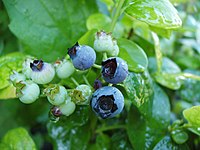

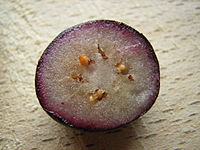
![Structure of anthocyanins, the blue pigments in blueberries.[13]](http://upload.wikimedia.org/wikipedia/commons/thumb/c/cd/Anthocyanidine.svg/200px-Anthocyanidine.svg.png)
